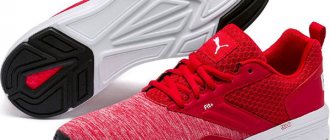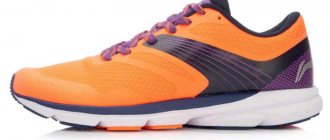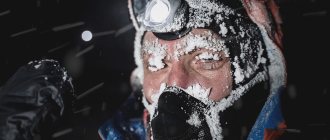“Hello, I need sneakers for running in winter,” many of us have approached a store consultant at least once in our lives with such a request. Snow, slippery surfaces, cold winds - all these factors are very different from what runners are used to in the warmer months.
What is the difference between winter running shoes and conventional “summer” ones? How to choose the right pair for yourself from a wide variety of models? Does everyone need winter spikes? And finally, what do leading athletes wear in winter competitions? We will try to answer all these questions in this article.
Photo: salomon.com
Winter running is, first of all, running outdoors in temperatures below zero. As a rule, athletes during this period either do not conduct speed training at all, or transfer it to athletics arenas, and some go to warm, snowless countries for training camps and running camps.
Therefore, outdoors in winter in Central Russia, most runners usually train only at medium and low intensity. Based on this, shoe manufacturers develop their models specifically for a relatively low running pace.
However, the word “developing” is not entirely appropriate. Most of the world's brands simply take existing models of summer shoes as a basis and make the necessary changes. The logic of the modification comes directly from the characteristics of training in the cold season.
Is a membrane necessary?
On the one hand, the membrane is not completely blown out, and in its normal condition, without abrasions, damage or manufacturing defects, it does not allow moisture to reach the feet for a very long time. At the same time, water in a gaseous state, that is, evaporation from the feet, passes through the membrane.
Talk about the membrane still not holding water is incorrect. Due to its physical properties, it simply cannot allow water molecules to pass through it. Micropores in the membrane material - a film of polytetrafluoroethylene or, simply put, Teflon - are on average about 700 times smaller than a water molecule.
marathon and half marathon training plans and start training today!
Membrane under a microscope
Anyone who has doubts can conduct a small experiment at home: take any container of suitable size, fill it with water and place a membrane sneaker in it so that water does not pour in from above. For stability, you can put some weight inside the shoes. A sneaker can stand like this for at least a few days and remain dry inside.
Problems with the membrane appear when it is damaged - this happens when the shoes are used very intensively, or when at the factory it is integrated inside the sneaker with irregularities, for example, its seams are not carefully taped. But even in these cases, it significantly increases the moisture protection of shoes.
Another question is that for many competitions, runners specifically choose sneakers without a membrane if the condition of the track involves extensive and deep puddles and liquid slush. Then water, especially over a long distance, will sooner or later flood through the top, and here the membrane will do a disservice: it will interfere with the removal of moisture. You will have to run the rest of the distance with two “aquariums” on your feet.
Many manufacturers do not use a membrane, but simply make the upper of the sneakers more dense and impregnate it with water-repellent compounds at the factory. This significantly reduces the cost of shoes, while for ordinary city runs lasting an hour and a half, water and wind protection is quite enough.
In a word, it all depends on the situation. To summarize, for most training tasks, sneakers with a membrane or a dense upper treated with water-repellent impregnations will be preferable to regular summer ones, primarily in terms of comfort. For competitions, everything is more complicated: here you need to look at specific weather conditions and the condition of the track.
Examples of kits for winter jogging
Famous manufacturers of sports goods and clothing produce a line of winter clothes. They are popular among runners. Below are sets assembled from branded items.
Adidas
The set includes:
- compression trousers and thermal jacket;
- jacket with lining and insulation;
- sweatshirt;
- insulated, loose-fitting trousers with an elastic waistband;
- textile sneakers with comfortable front lacing;
- a cap.
Sneakers from Adidas for winter running.
Reebok
The ensemble is represented by:
- elastic two-layer thermal underwear made of soft fabric with flat seams;
- vintage style hoodie;
- synthetic trousers and jacket;
- leather sneakers;
- cotton hat.
Nike
The leading company in the production of sportswear presents a set of:
- elastic thermal pants with mesh inserts for ventilation;
- a two-layer turtleneck with the functions of removing moisture and retaining heat;
- jackets with a removable hood, elastic cuffs and reflectors;
- football jacket made of soft material with sweat protection;
- original design sneaker with a patterned sole for good grip on the ground;
- acrylic hat.
Winter suit from Nike.
Puma
The set does not include thermal underwear, since the company does not produce it.
Other details:
- compression T-shirt;
- double nylon jacket with fleece lining;
- cotton and polyester sweatshirt;
- cotton trousers with elastic waistband and fleece;
- textile sneakers;
- acrylic hat.
Jackets and sneakers for winter running from Puma.
Asics
The manufacturer of a sports clothing line took care of the comfort of runners by releasing items that can be combined:
- thermal underwear;
- textile jacket;
- sweatshirt with hood, pockets and zipper;
- lightweight trousers with moisture-wicking function;
- sports hat;
- studded sneakers.
Mizuno
The collection of this company includes a running T-shirt, thermal pants, a jacket with a hood, insulated trousers, warm sneakers with a breathable insole, and a fleece hat. The materials are hypoallergenic and have antibacterial impregnation.
Running suit from Mizuno.
Ice running
To prevent running from turning into figure skating, manufacturers offer several technological solutions.
1.Pre-installed spikes
If you mostly run on ice and dense snow, then you should take a closer look at running shoes with spikes. The principle here is the same as in simple winter sneakers: a proven summer model is taken, protection of the upper from water is added, and the sole is equipped with metal spikes, usually made of tungsten alloy.
The shape and location of the spikes differ in different models.
Let's compare two popular models for winter running with spikes: on the left, Salomon Spikecross 5 GTX, on the right, ASICS Fujisetsu 3 GTX. As we can see, the Salomon has all but one of the studs located around the perimeter of the sole, while the ASICS model has both in the heel and in the forefoot.
The shape of the spikes is also different. In the photo on the left are ASICS studs located on a wide base washer. Salomon does not have this; the studs are of a slightly different design and, in addition, are slightly recessed into the rubber of the outsole.
Self-screwing spikes
Some manufacturers give the athlete the opportunity to customize his shoes for running on slippery surfaces. For example, the American brand Saucony produces the Peregrine model, currently in its eleventh iteration, into the sole of which spikes can be screwed into certain places. A set of spikes is not included and must be purchased additionally.
The photo clearly shows these places: ten cylindrical protrusions with cross-shaped marks
The spikes can also be screwed into regular sneakers without places marked for this purpose by the manufacturer. In this case, it is only important to make sure in advance that the soles are strong and place them in a reasonable order. Often, for these tasks, they choose a running pair of “retirement” age with significant mileage, which you don’t mind.
When screwing in, you should focus on the places where the sole wears the most, since this is where the foot contacts the surface. Usually ten to twelve studs per shoe are enough. It is worth saying that when unscrewing, holes are left in the outsole, so the studding procedure for a sneaker is, by and large, a one-time thing: it is better to choose a pair, screw the studs into it and not touch them again - these will be shoes specifically for running on ice.
"Cats"
There are also options for removable running “crampons”. They significantly increase traction, especially on mountainous terrain. They can be successfully used in skyrunning, difficult trails, runs on the icy surface of reservoirs, in general, where maximum tenacity is extremely important.
Photo: nortecsport.com
The downside to such devices is the added weight on the legs. Even the lightest crampons weigh about a hundred grams each, so you should think carefully before deciding to use them.
Reviews from athletes
Before you go to the store and buy the right sneakers, we suggest you read customer reviews:
- Evgeniy: I never thought that buying men's running shoes in winter would be so difficult. I tried many options, and came to the conclusion: it is better to buy models from trusted brands so that the shoes at least survive until spring. I recently chose Adidas for myself, so far I’m happy with the use.
- Maria: I bought Nike winter shoes for my son. I was pleased because the thick sole prevents my feet from getting cold, and the natural suede and leather extend the service life. Fashionable and high quality, so both me and my son like them.
- Oleg: I’ve been doing sports for a long time, without taking breaks for the winter. I've been eyeing a pair of Salomon Speedcross 3 GTX sneakers. I ran all the cold weather, the shoes passed the test, there are no complaints. It washes quickly, doesn’t get wet, your feet don’t sweat, and there’s no unpleasant smell after you take it off.
The right choice of sneakers will allow you to motivate yourself to play sports and get only pleasure from an active winter.
Running in slushy snow
The loose snow surface requires deep tread from sneakers, so models based on summer mud ones are suitable.
Gaiters will be a useful addition. They will not allow snow to get through the top of the sneakers and will additionally insulate the foot. There are models of sneakers with an already integrated gaiter.
Running on asphalt in sub-zero weather
If the asphalt is at least minimally cleaned, there is no strong cold wind, and the run is not very long, then, in principle, you can get by with a summer pair of shoes. There should be enough grip for an average runner.
However, for beginners with their still fragile ligaments and stabilizer muscles, it is better to choose options from the winter collections of brands. The outsole there holds better on slippery surfaces, plus running in shoes with a windproof upper is much more comfortable and warmer.
When running on cleaned asphalt, you should be careful, since even at a generally positive temperature, small puddles and smears can freeze, especially in the mornings and evenings, and in low light they can be practically invisible to the eye. There are known cases of runners falling and getting injured on such ice even in early April.
New Balance 574 Rugged Gore-Tex
You can also buy winter running shoes in Moscow and throughout Russia from New Balance. The brand offers high quality and its own proprietary technologies, such as ENCAP cushioning with a lightweight, springy EVA midsole. The leather and synthetic upper is complemented by a water-repellent Gore-Tex membrane.
New Balance 574 Rugged Gore-Tex Price: RUR 16,990 Buy: newbalance.ru
Also don't miss: TOP 10 sneaker models we'll see in 2022
Special soles
A good option for running on winter asphalt is offered by the trendsetter in the world of outdoor soles – the Italian brand Vibram. His development - a special Vibram Arctic Grip outsole - has earned good reviews from runners and numerous awards from the global tourism community.
Its essence is that instead of metal spikes, flat inserts made of special multi-component rubber are used in the sole. They are rough to the touch, since they contain, among other things, glass, fit tightly to the coating and cling to both trampled snow and icy, as well as wet asphalt. At the same time, the sole is durable and bends well.
These highly abrasive, sandpaper-like elements are used not only in running models, but also in urban shoes for everyday wear and in winter hiking boots.
The grip on ice here will be worse than in shoes with spikes, but noticeably better than any “summer” tires. In addition, such an outsole, unlike spikes, is universal, wears off at the same speed as a regular one when running on asphalt, and does not slip on paving stones and tiles.
Cloth
bottom layer
The main rule of winter running gear is layering. After all, running in winter always means running in two temperature zones. At first, while your body has not yet warmed up, you feel the real temperature of the environment, that is, you are cold. But 10 minutes after you start jogging, you may feel hot. Therefore, with winter equipment it is better to adhere to the principle of multi-layering, so that you have something to take off if it gets very hot, and at the same time not catch a cold.
Usually, thermal underwear with long sleeves made of special fabrics is worn down, which do not release heat, allow the body to breathe and at the same time remove excess moisture, that is, your sweat. Some people wear cotton T-shirts or knitted sweaters with long sleeves (long sleeves), but in this case you run the risk of catching a cold, since if you sweat a lot, knitted clothing gets wet and doesn’t dry well. Running in wet clothes in winter is not very comfortable or correct. However, if you are going for a short and not very intense run, you can use this option, provided that the top layer will reliably protect you from wind and cold.
Upper layer
The top layer of clothing depends on the temperature. For example, it’s sunny outside and the thermometer shows –1 °C. In this case, your choice is a thermal jacket with long sleeves (long sleeve) and a light jacket on top. If it’s cooler outside (-10°C), it’s better to choose a warmer running jacket. Some runners don't wear a light jacket on top, but a thin woolen sweater.
Bottom part
There are several options for insulating the lower part. Firstly, it would be a good idea to buy thermal underwear - this is an almost 100 percent guarantee that you will always be warm. You can wear tights (tight pants) over thermal underwear for winter running. They usually also come with a thermal label. If for some reason you don’t want to run in tight pants, you can choose the second option - warm fleece ones, under which you will wear warm tights or thermal long johns. Since fleece pants come in different thicknesses, you can choose from several options for colder and warmer weather. It is advisable that they have elastic or cuffs at the bottom: this way cold air will not get inside.
The second option is to wear shorts over the tights, either fleece or thick cotton.
Some tips for choosing socks
- For winter running, special socks are usually used. They are higher than summer ones, and more dense, additionally insulating the ankle area.
- Regular compression socks would be a worthy option. They warm the entire calf muscle well and support small stabilizer muscles, which is especially useful when running on uneven and sometimes slippery surfaces.
- In addition to athletic socks, specialized models for cross-country skiing are also suitable.
- In terms of materials, a mixture of wool and various artificial fibers has proven itself well. However, there are also excellent options for purely synthetic socks. Almost every major running brand has similar models. It is also worth paying attention to companies specializing in the production of socks and thermal underwear. Thanks to such a narrow focus, they often achieve great success and produce very high-quality, although not cheap, products.
- Do not use purely cotton socks, or too thick woolen ones. Cotton quickly absorbs moisture and releases it for a very long time, so the sock can cool the foot. A too thick “grandmother’s” woolen sock, on the contrary, can be too warm, which is also unnecessary.
How to run properly in winter
For many people, winter running raises questions and concerns:
- Is it possible to do this?
- Isn’t this a wild type of activity (What will people think?)
- How to dress properly when going for a run in the dead of winter?
- Is this a surefire way to catch a cold or worse?
But the arrival of the winter season should not force you to give up daily jogging. Moreover, running in winter can be a very beneficial activity if done correctly.
Winter running rules
- Active warm-up – it is especially important to warm up the leg muscles well. Before you start running, you need to start with a simple walk and slowly increase the pace. To avoid bronchial disease in winter, you should not swallow icy air through your mouth. So you need to choose a comfortable running speed at which you can breathe enough.
- You can move at the same speed all the time - this allows you to simply maintain good tone for the body. And you can periodically change your running speed - this already promotes more vigorous fat burning.
- When jogging, you need to make sure that your head is kept straight and your shoulders are down. The body itself is held with a slight tilt forward.
- When running, do not forget to use your hands - they must work actively and be bent at the elbows.
- At the end of a winter run, the running pace first slows down, then you can switch to walking. You can't stop running during the cold months! Either running or quick steps.
Recommendations
- If the temperature outside is very low, you can pull a scarf over your nose;
- A positive psychological attitude helps a lot when jogging - cheerful, energetic music in headphones will contribute to this;
- It is better to choose places for running in cities with the cleanest air and non-slippery roads;
- Pharmacies sell special hygienic lipstick - it can be used to prevent chapped lips in the cold.










